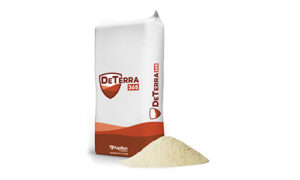You’ve heard it time and again: not all magnesium (Mg) sources are created equal, magnesium oxide (MgO) is highly variable, and price does not always equate to bioavailability. So how can you tell if your supplemental Mg source is both soluble and bioavailable? Will a quick, in vitro vinegar test provide the answer?
The idea behind the vinegar test is simple. Take two or more substances that are intended as feed supplements, place them separately in a fixed amount of vinegar (pH ~2.7), and after a set amount of time, measure the pH of the solutions. The substance that raises the pH the most, or has dissolved the most, is the most soluble.
Vinegar Test Pros and Cons
This test is an easy way to compare the solubility of chemically identical substances, such as two different MgO sources, in vinegar. However, this information does not directly translate into bioavailability or ruminal “buffering” estimates, which is typically the reason for running the test. It only tells you if the products react differently in vinegar.
The main reason the vinegar test comes up short is that rumen pH regulation is far more complex than proton neutralization by the dietary addition of bicarbonate ions or carbonates. For example, short chain fatty acids (SCFA) can be absorbed through the rumen epithelium. Absorption of dissociated SCFAs involves an exchange with a bicarbonate ion in addition to the removal of a proton, essentially neutralizing two “units” of acid with one action. Moreover, there are different pathways for this absorption depending on the type of fatty acid, rumen pH, feed intake, as well as other factors. Beyond direct removal of SCFAs, salivary buffer supply also contributes greatly to pH regulation and it too depends on ruminal pH and feeding management.
Given that multiple mechanisms and variables impact ruminal pH regulation, the only way to really determine your supplement’s buffering capacity or mineral bioavailability is to conduct in vivo trials in commercially relevant situations (or request said research results).
Do Your Research
Two research trials illustrate the importance of moving beyond the vinegar test to obtain concrete proof that your supplemental Mg source will perform as expected:
Trial 1 assessed Mg absorption in wethers and showed that apparent retention, apparent absorption, and true absorption of Mg from calcium magnesium carbonate did not differ significantly from MgO but were significantly higher than in magnesite and Mg sulphate (Zyzak et al., 2002). Solubility and rate of dissolution results from the vinegar test would not lead to the same conclusion because both MgO and Mg sulphate dissolve more rapidly than carbonates.
Trial 2 was conducted at the University of Missouri and compared MIN-AD®, a calcium magnesium carbonate, with a competing dolomite, MgO, and a control. The competitor dolomite had the same particle size distribution and chemical assay as MIN-AD. Results showed an unequivocal statistical increase (P<0.05) in propionic acid and total VFA production with MIN-AD as compared with the competitor dolomite. This demonstrates that products that are allegedly the same, can differ in a fermentation environment and perhaps even more so in vivo (MIN-AD Internal Tech Note B-4).
Industry Insights
There is strong support for continued in vivo research. In a Tri-State paper on supplemental Mg sources, Dr. David Beede states, “Overall, it does not appear that the in vitro solubility test in a buffered system suggests anything about the lactational responses one should expect” (2017). He concludes, “Unfortunately, determination and ranking of Mg sources by solubility as an indicator of apparent availability does not appear to be a very reliable test.” A University of Guelph study comparing the reactivity of mineral sources by the vinegar test states, “to determine whether or not these differences are physiologically significant would require further experiments in live animals” (Carpenter, 2017).
In vitro tests are still performed by some mineral supplement suppliers because they are relatively cheap and can be conducted without the reputational risk and expense of having to demonstrate an in vivo production result at a third-party institution. The importance of in vivo research when considering a supplemental Mg source for your rations cannot be overstated.
MIN-AD is the only calcium magnesium carbonate supplement backed by over 30 years of research. Click here to learn more.
References
Beede, D. 2017. Can we differentiate supplemental magnesium sources nutritionally? In Tri-State Dairy Nutrition Conference Proceedings (pp.99-107)
Carpenter, G. (2017, September 15) Reactivity of minerals for dairy cattle estimated through the “white vinegar test” [Paper presentation] University of Guelph Ridgetown Campus, Ridgetown, ON N0P 2C0
Zyzak, W., Brzoska, F., Brzoska, B., Michalec-Dobija. 2002. The solubility and availability of magnesium from calcium-magnesium carbonate and magnesium carbonate. Journal of Animal and Feed Sciences. 11(4):695-707.





